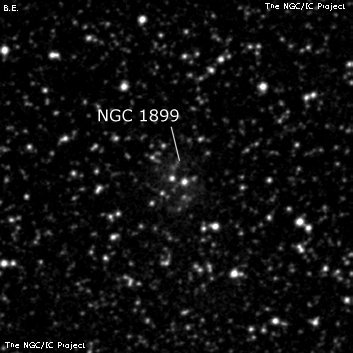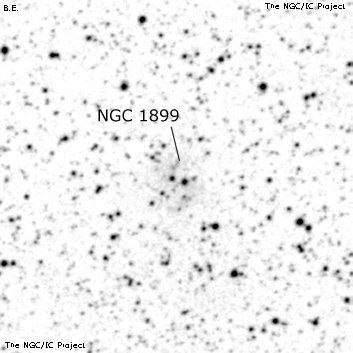NGC/IC Project Restoration Effort
(This is a very very beta version)
NGC1899


Basic Information
Location and Magnitude
Right Ascension: 5:17:46.0
Declination: -67:54:0
Constellation: DOR
Visual Magnitude:
Historic Information
Discoverer: Herschel J.
Year of discovery: 1836
Discovery aperture: 18.3
Observational
Summary description: F, pS, R, vglbM, 3 st 10 p
Sub-type: EN
Corwin's Notes
=====
NGC 1899. The usual object taken as NGC 1899 is a very faint nebulosity,
perhaps a reflection nebula, surrounding two brighter stars and several
fainter ones. However, it is very faint, and is southeast of JH's position by
about two arcminutes, further off than most of his LMC positions.
My hesitation over this has led me to a group of faint stars near JH's place.
But these are probably not sufficiently concentrated to appear nebulous at the
eyepiece.
JH's observation book has this as number 34 in Sweep 759 on 30 December 1836.
It fits comfortably within the bounds of the sweep -- only a degree wide, and
there is no suggestion of anything wrong with the position. The description
is correctly copied into the CGH monograph as is the position. The one thing
that might offer an additional clue is a little sketch showing what is
apparently a nebula with three stars preceding. JH says "three stars 10[prime]
m precede" (where the [prime] perhaps means "approximately"). Unfortunately,
I cannot relate that little sketch to what I see on the DSS2 red image of the
area -- there are two relatively bright stars preceding JH's position with
four or five others in the area, but they do not match the right triangle JH
has drawn.
I've also checked at reasonable positions that could result from a digit error
in JH's position, but there is nothing that matches his description, or his
note about the three stars.
So, by default, the faint nebulosity may indeed be JH's object, and my
misgivings about its faintness unfounded.
But, when I checked Jenni Kay's LMC observations, I found that she did not see
the object at either 110X or 150X in her 12.5-inch F5 Newtonian, simply
noting, "Too faint."
We clearly need an observation with a 15- to 20-inch telescope.
Steve's Notes
=====
NGC 1899
30" (10/15/15 - OzSky): at 303x and 394x; no cluster or nebulous object was in the field at the nominal position, which included three mag 11 stars and the rest mag 13 and fainter. I see nothing that would have caught John Herschel's attention in the field.



